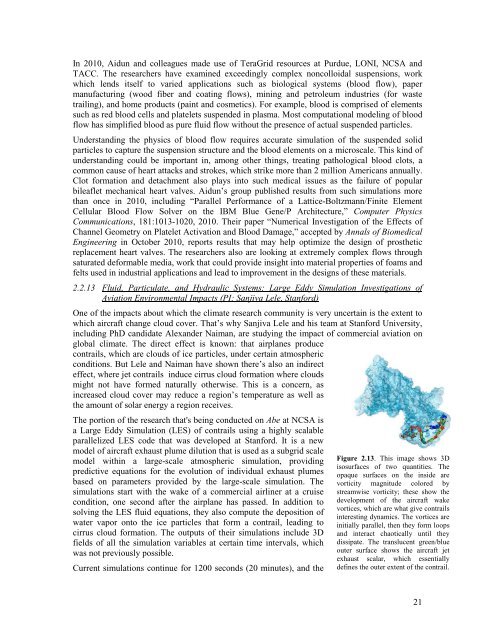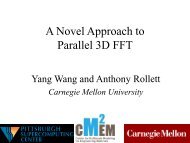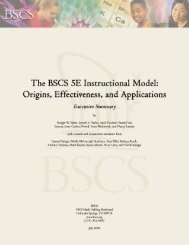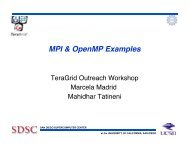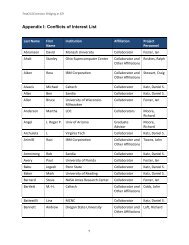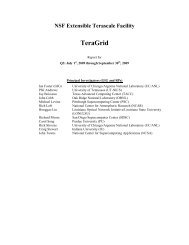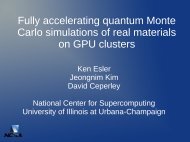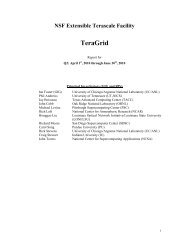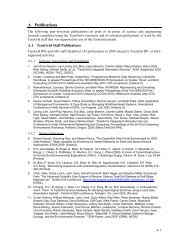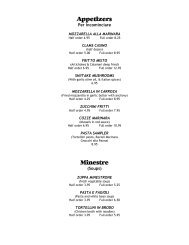TGQR 2010Q4 Report.pdf - Teragridforum.org
TGQR 2010Q4 Report.pdf - Teragridforum.org
TGQR 2010Q4 Report.pdf - Teragridforum.org
You also want an ePaper? Increase the reach of your titles
YUMPU automatically turns print PDFs into web optimized ePapers that Google loves.
In 2010, Aidun and colleagues made use of TeraGrid resources at Purdue, LONI, NCSA and<br />
TACC. The researchers have examined exceedingly complex noncolloidal suspensions, work<br />
which lends itself to varied applications such as biological systems (blood flow), paper<br />
manufacturing (wood fiber and coating flows), mining and petroleum industries (for waste<br />
trailing), and home products (paint and cosmetics). For example, blood is comprised of elements<br />
such as red blood cells and platelets suspended in plasma. Most computational modeling of blood<br />
flow has simplified blood as pure fluid flow without the presence of actual suspended particles.<br />
Understanding the physics of blood flow requires accurate simulation of the suspended solid<br />
particles to capture the suspension structure and the blood elements on a microscale. This kind of<br />
understanding could be important in, among other things, treating pathological blood clots, a<br />
common cause of heart attacks and strokes, which strike more than 2 million Americans annually.<br />
Clot formation and detachment also plays into such medical issues as the failure of popular<br />
bileaflet mechanical heart valves. Aidun’s group published results from such simulations more<br />
than once in 2010, including “Parallel Performance of a Lattice-Boltzmann/Finite Element<br />
Cellular Blood Flow Solver on the IBM Blue Gene/P Architecture,” Computer Physics<br />
Communications, 181:1013-1020, 2010. Their paper “Numerical Investigation of the Effects of<br />
Channel Geometry on Platelet Activation and Blood Damage,” accepted by Annals of Biomedical<br />
Engineering in October 2010, reports results that may help optimize the design of prosthetic<br />
replacement heart valves. The researchers also are looking at extremely complex flows through<br />
saturated deformable media, work that could provide insight into material properties of foams and<br />
felts used in industrial applications and lead to improvement in the designs of these materials.<br />
2.2.13<br />
Fluid, Particulate, and Hydraulic Systems: Large Eddy Simulation Investigations of<br />
Aviation Environmental Impacts (PI: Sanjiva Lele, Stanford)<br />
One of the impacts about which the climate research community is very uncertain is the extent to<br />
which aircraft change cloud cover. That’s why Sanjiva Lele and his team at Stanford University,<br />
including PhD candidate Alexander Naiman, are studying the impact of commercial aviation on<br />
global climate. The direct effect is known: that airplanes produce<br />
contrails, which are clouds of ice particles, under certain atmospheric<br />
conditions. But Lele and Naiman have shown there’s also an indirect<br />
effect, where jet contrails induce cirrus cloud formation where clouds<br />
might not have formed naturally otherwise. This is a concern, as<br />
increased cloud cover may reduce a region’s temperature as well as<br />
the amount of solar energy a region receives.<br />
The portion of the research that's being conducted on Abe at NCSA is<br />
a Large Eddy Simulation (LES) of contrails using a highly scalable<br />
parallelized LES code that was developed at Stanford. It is a new<br />
model of aircraft exhaust plume dilution that is used as a subgrid scale<br />
model within a large-scale atmospheric simulation, providing<br />
predictive equations for the evolution of individual exhaust plumes<br />
based on parameters provided by the large-scale simulation. The<br />
simulations start with the wake of a commercial airliner at a cruise<br />
condition, one second after the airplane has passed. In addition to<br />
solving the LES fluid equations, they also compute the deposition of<br />
water vapor onto the ice particles that form a contrail, leading to<br />
cirrus cloud formation. The outputs of their simulations include 3D<br />
fields of all the simulation variables at certain time intervals, which<br />
was not previously possible.<br />
Current simulations continue for 1200 seconds (20 minutes), and the<br />
Figure 2.13. This image shows 3D<br />
isosurfaces of two quantities. The<br />
opaque surfaces on the inside are<br />
vorticity magnitude colored by<br />
streamwise vorticity; these show the<br />
development of the aircraft wake<br />
vortices, which are what give contrails<br />
interesting dynamics. The vortices are<br />
initially parallel, then they form loops<br />
and interact chaotically until they<br />
dissipate. The translucent green/blue<br />
outer surface shows the aircraft jet<br />
exhaust scalar, which essentially<br />
defines the outer extent of the contrail.<br />
21


